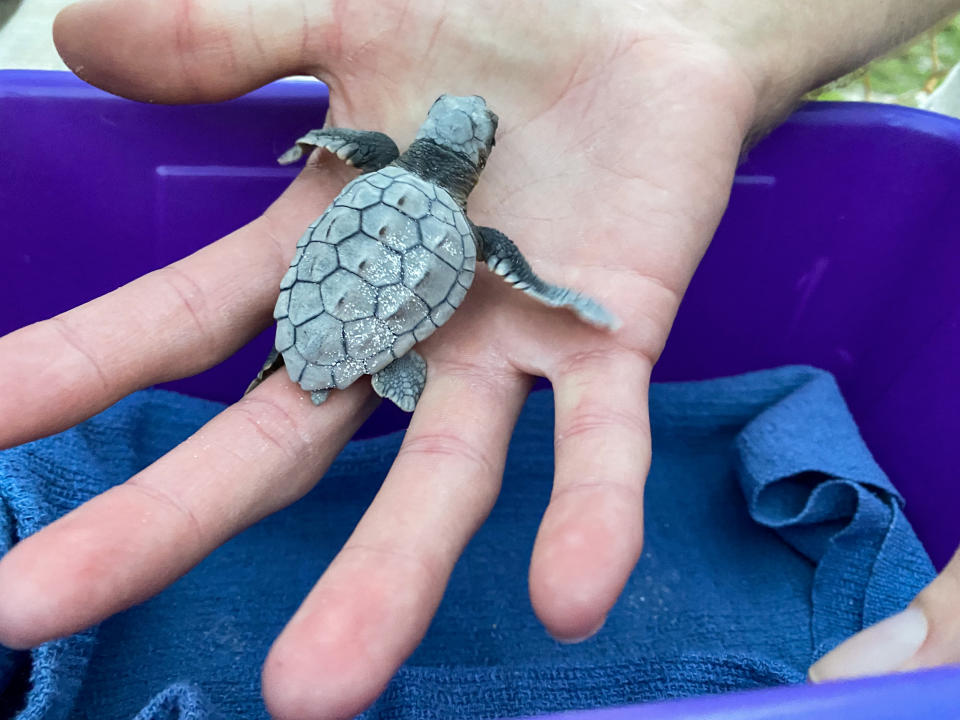Rising Temperatures Cause Florida Sea Turtles to Be Born Female
The climate crisis’ impact on sandy beaches affects more than just rising sea levels and how much sunscreen we apply. It’s also contributing to an upswing in the number of turtles that are born female.
Unlike humans, whose sex is determined at fertilization, the sex of sea turtle hatchlings is temperature-dependent.
According to the National Oceanographic Atmospheric Administration, if a developing sea turtle egg incubates above 88.8 degrees Fahrenheit, the hatchlings will be female. If an egg incubates below 81.86 F, it will be male. Anything in between will produce a mix of both.
Here's where the current climate conditions come into play. In Florida, temperatures in July range from 90 to 95, according to Florida State University’s Climate Center. A recent report from Reuters revealed that a rise in temperatures has caused an imbalance of the sexes.
Speaking to TODAY, Bette Zirkelbach, a manager at Turtle Hospital in the Florida Keys, said sea turtle biologists have studied hatchlings and the remains of unhatched eggs.
"They have found over the past four summers that there have been no male sea turtles," she explained. "The ratios have been going up steadily (to show) more and more females, but to think that there have been no boy turtles. Without boy turtles, we're not going to have baby turtles."
And it's not just affecting the sea turtles of Florida. In 2018, a study published by Current Biology revealed that in Australia's northern barrier reef area, beaches had become particularly female-biased. The study also found that for more than two decades, rookeries (breeding colonies) had produced a greater number of female sea turtles.
The results of their study found that in more cool and southern Great Barrier Reef (GBR) nesting beaches, sea turtles showed a moderately female sex bias (65%–69% female). Meanwhile, the population of sea turtles that originated from warmer, more northern GBR nesting beaches was extremely female-biased, with 99.1% of juvenile, 99.8% of subadult, and 86.8% of adult-sized turtles being female.
"The complete feminization of this population is possible in the near future," the study said.

Sea turtles are considered keystone species, according to Zirkelbach, meaning that other organisms in their ecosystem largely depend on their presence, particularly in imparting balance among prey and helping seagrass beds flourish. Without sea turtles, the natural order of the marine ecosystem would be entirely disrupted. That's why Zirkelbach says these findings on sea turtles' female population are particularly alarming.
"Sea turtles have been on our planet for over 110 million years. And I think that's a really important part of the story because they have evolved and survived our oceans for over 110 million years," Zirkelbach noted. "They were swimming in our oceans when dinosaurs were on our lands, so it's really hard to even think about or conceive as a human to think about that."
The lopsided male-to-female ratio means successful breeding efforts aren't coming about either.
At Turtle Hospital, where Zirkelbach works, there are currently 37 turtles in their care. According to Zirkelbach, most of the juvenile turtles are female.
Compounding this issue is the fact that sea turtles take as long as 20 to 25 years to become sexually mature. This means that scientists won't be able to measure the implications of current hot summers for another decade or more. That extended interval of sexual reproduction is particularly significant considering, as Zirkelbach puts it, "Some of the scientists now may not even be here when it is affecting the population."

